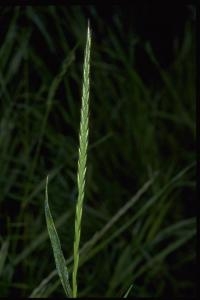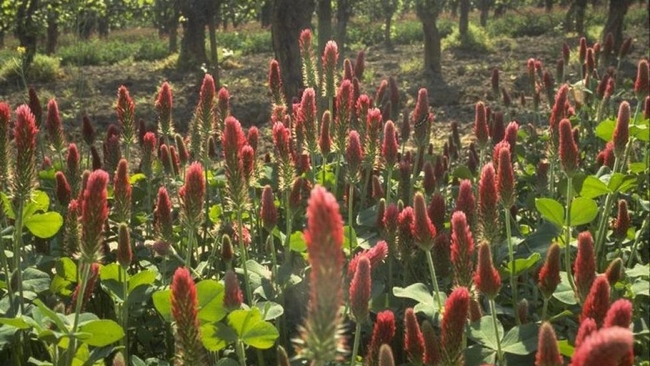What are cover crops?
Cover crops are plants used for improving soil in the off-season. These are frequently called green manure to emphasize their multiple benefits to the soil. Using cover crops is actually an ancient technique; references to them are found in Chinese manuscripts from 3,000 years ago and as well as in Greek and Roman writings.
Benefits of cover crops
- Improve the physical properties of the soil, helping it form a crumbly structure.
- Increase the soil's organic material. This helps feed the soil microbes that improve the soil, and keeps nutrients from washing out of the soil, releasing them slowly instead.
- Protect the soil surface, keeping it from blowing or washing away.
- Improve water retention, water infiltration and drainage.
- Break up compacted soil and hardpan. (Legumes like vetches, clovers and beans, mustards and annual grasses are great at this!)
- Provide habitat and food for beneficial insects.
- Allow for an increase in earthworm populations, if the soil is left undisturbed for 5 to 7 months.
- Legumes increase nitrogen in the soil available for plants can use.Kinds of cover crops
Type of cover crops
Winter cover crops can be divided into three types, commonly used together:
- Legumes - commonly vetches, clovers, beans (bell or fava). Legumes actually add nitrogen to the soil. Legume roots are symbiotically associated with root-zone (rhizobial) bacteria. These bacterial threads enter the plant through the root hairs, multiply, enter the main part of the roots and then rupture. The bacteria then can enter the root cells, which enlarge into nodules. In these nodules, the bacteria can grab nitrogen from air in the soil and convert it into a form plants can use (ammonium). This is commonly called “fixing” nitrogen. In return, the legume gives the bacteria carbohydrates, protein, and oxygen. When the top of the cover crop is cut, the nodules remain in the soil and release their nitrogen, which is then available for uptake by plants. Legumes also have large tap roots that can break up the soil.
 Vetch photos UC SAREP Bob Bugg
Vetch photos UC SAREP Bob Bugg - Annual grasses - commonly barley, oats, cereal rye. These are sometimes considered “nurse” plants. They germinate fast and provide cover and soil-holding while the slower legumes start up. Grasses provide soil organic matter even as they grow because they commonly slough off dying roots and grow new ones. Because they have a lot of biomass above ground, they also provide a lot of carbon material when cut down.
 Annl Rygrass UCSAREP Jack Kelly Clark
Annl Rygrass UCSAREP Jack Kelly Clark - Miscellaneous - mustards (white, brown, black and field), phacelia, radishes such as daikon. Mustard leaves gather and store existing nitrogen from the soil, keeping it from washing out, and contribute it back in usable form when worked back into the soil. Legumes do this as well, in addition to their “fixing” capabilities described above. Keeping nutrients in the top layer of soil is particularly a problem in sandy soil.
Cover crops by function
|
Adding organic material to soil |
Annual grasses like barley, oats or rye, which provide a lot of carbon material. Daikon radish also produces a lot of biomass. |
|
Increase nitrogen |
Legumes (esp. vetch, clover and bell beans). Fava beans work well too, but their seeds tend to be more expensive. |
|
Breaking up compacted soil and hardpan |
Plants with large or deep roots such as daikon radish, chicory, mustards and legumes. |
|
Holding nutrients in the soil so they don't leach out |
Mustards, radishes and legumes. |
|
Protecting the soil from erosion and suppressing weeds |
Grasses, mustard, and radish. |
|
Attracting beneficial insects |
Mustards and radish, which may unfortunately also attract undesirable insects such as cucumber beetles and stink bugs. |
Chart adapted from UC Master Gardeners of Marin County, https://marinmg.ucanr.edu/EDIBLES/COVERCROPSETC/
- Mixes. Many gardeners use a blend designed for use as a soil-building cover crop. Blends generally have legumes for adding nitrogen and annual grasses to produce lots of biomass to add to the soil. Other species may be useful as well for particular needs, as outlined in the table above. Something that flowers (maybe a clover?) is a nice addition.
Planting
- In Alameda County, cover crops can be seeded in late September to mid-November. Spreading a light but even sprinkling of seeds should be sufficient. The goal is to get at least 8 to 10 cover plants per square foot.
- Not much soil prep is needed. The easy first step: take the existing plants off the surface and irrigate well. After a few days, scatter the cover crop seeds on the surface then rake them in well with quick short strokes in one direction to cover them with soil. Use a rake with rigid tines, not a leaf rake. Mulch with straw or leaves, water well again, and it's planted. (Note: never use diseased or infested leaves as mulch; put them in your green bin for municipal composting.)
- Until it starts to rain, provide irrigation. After the rains start, check periodically to make sure the crop is growing and not wilting. Some irrigation may be needed throughout the winter if it's very dry.
Cutting down and incorporating into the soil
- Cover crops in Alameda County may be cut down between late February and early April.
- There are two schools of thought on the time to cut down the crop. For a quick result, cut the cover crop down when it first begins to flower, the plant matter will still be succulent and the crop will decompose quickly to provide nitrogen to the soil. If you have time, for additional benefit you can wait to cut down until half to full bloom and the crop will add also additional organic matter to the soil. This technique is better for gradually improving soil that needs help, but you may not be able to replant as soon.
- Whenever a legume crop is cut, it is important to keep the root material in the ground. Just remove the tops. This will disturb the plant enough that the nodules on the roots of the legumes slough off within three days to a week. This releases the nitrogen in the nodules into the soil. When the soil is dug to plant, it's easy to pick out any nodule-less root materials that have not decomposed.
- There are two techniques for getting the cut plant materials back into the soil. The first is to chop them up and immediately dig them into the soil. If the beds are large, this can mean a lot of digging. At least three to five weeks are then needed for the plant material to decompose enough for replanting. The alternative is to take the cut plant tops, chop them up and put them into a compost pile with a source of carbon (dead leaves, straw, etc.) When the compost is ready, return it back to the cover crop bed. How long it takes to make the compost depends on many factors. Composting in a Hurry. Composting Basics. If you want to replant immediately, you can instead add compost that you have purchased or made previously.
- When you aren't growing anything, the bed should be mulched, not left bare. Compost, non-diseased and non-infested leaves (green or brown), straw, and arborist-sourced wood chips are excellent mulches for this.
Using cover crops to improve the soil in your veggie plot takes a minimum of work while both the gardener and the soil rest and rejuvenate through our rainy season.
Resources:
- Comprehensive resource for home gardeners and the principal source for this post: Choosing and Using Cover Crops in the Home Garden and Orchard, Center for Agroecology and Sustainable Food Systems (CASFS)
- Great summary of benefits and drawbacks of cover crops from the UC Marin County Master Gardeners
- Cover crop information from UCANR SAREP (Center for Sustainable Agriculture Research and Education Program)
- Information on Tansy Phacelia, which has been used widely in Europe as a cover crop, but can attract problematic pests in California, particularly the Lygus bug, a hard-to-control pest of strawberries, tomatoes and other crops.
Alameda County Master Gardeners Help Desk:
This blog post is brought to you by the Help Desk of the Master Gardeners of Alameda County.
Have a gardening question? We'll help. You can reach us by:
- Emailing acmg@ucanr.edu. Please include a photo of the problem, if you can, plus your name, phone number, and city and a description of the problem.
- Using our online form: https://surveys.ucanr.edu/survey.cfm?surveynumber=16371
By phone, during our office hours, 10am to noon Wednesday and noon to 2pm Thursday: 510-670-5645. At other times, please leave a message and we'll return your call during our office hours - In person at our Hayward office, during our office hours, only by appointment.


